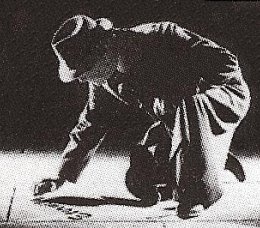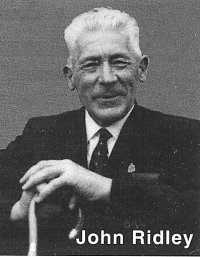
Chalk Artist Supplies
Over 60 Colors of chalk... more
For the sidewalk artist, gospel artists, and many other uses. You can purchase any of our basic chalk colors by the stick or in selected sets. For optimum vibrancy, try our fluorescent chalk. It "pops" on paper or sun-lit concrete! And especially for inside presentations, we have a nice assortment of black light chalk for some incredible special effects.
Plus, we some other essential chalk artist supplies like sanding blocks, blending blocks, Kwik-Wipes, and hand soap. If you need bogus paper, we carry that as well.

Gospel Artist Drawing Equipment
Easels, lighthoods, ... more
Whether you are a full-fledged gospel artist or aspiring to be one, there are basic tools of the trade that you need. One of those items is a good-quality easel with a lighthood if you are going to be doing special effects with your drawings. And of course, if you're creating "hidden images" with black light chalk you'll need black light bulbs and black light safety glasses..
As your audience grows in size, your need for voice amplification will increase dramatically. Here's a great amplifier, speaker, and microphone system that will provide nice-sounding, broadcast volume for your presentations.

Formal Chalk Art Training
Courses, training events ... more
If you are new to chalk drawing, you what to check out the introduction to chalk drawing. It answers the question, who can be a chalk artist. Then you should read the history of chalk art so you can see how this amazing art form has changed and grown over the years.
For the optimum training experience, we offer a live Phase I class where you can get instant feedback, great one-on-one instruction, and meet other experienced and beginning artists. This live class is only scheduled one time a year so if you don't want to wait for a class, you can get the next best thing in the comfort of your own home — the whole Phase I Course on DVD. In either case, you can meet the Phase I Instructor right here.
Once you've mastered the basics, you're ready for advanced training in our Phase II course. Sorry, this course is only available in a classroom setting, once a year. But, it's definitely worth the wait and the investment in time and money!
Phase II Classes Coming April 1-5, 2024.
Register now!

Books and DVDs
Art presentations and tips ... more
Need some ideas for your own chalk art presentation. We've got a great a book that will get your creative juices flowing. We also have a number of fascinating chalk artist video presentations on DVD that will inspire and give you lots of great chalk drawing tips. And then, as a way to promote your chalk drawing avocation, grab some beautiful note cards featuring some of Matt Bowman's best gospel drawings on the front.
The Story of Mr. Eternity
Of Sydney, Australia
A little man that was a least likely. Two billion people saw his one-word message at one time. His message became the message for the Twenty-first century and the new millennium.
In 1999 the big scare of Y2K had many afraid of the uncertainty that lay ahead. The whole world waited breathlessly watching the news to see what would happen when the First Major Country for the date change would take effect. The new millennium began with a bang in Sydney, Australia. On the tick of midnight Dec. 31, 1999 the huge fireworks display erupted over Sydney Harbour to the delight of more than a million people, who watched from the foreshores and watercraft on the harbour.
This was the display to end all displays. It was designed to outdo every other New Year's celebration on planet earth, and it seems to have achieved its goal. For twenty-four hours the world media ran continuous commentary of celebrations on every part of the globe.
From remote islands in the Pacific Ocean, New Zealand, Australia, Hong Kong, across Asia to the Middle East, and on into Europe to France's Eiffel Tower and England's Millennium Dome. Then, as the earth spun at 1,000 miles per hour, across the Atlantic we saw the richest and most powerful nation on earth, the United States of America, in the freeze of winter join the celebration of a thousand years; but nothing compared with the brilliance of Sydney Harbour on January 1, 2000.
What was the reason for Sydney's success in surpassing every other display around the globe? Was it the amount of money spent on the fireworks? Or the fact that Australia has such incredible skills in developing fireworks extravaganzas? Perhaps in the year of Sydney's Olympic Games, it was intended to put the city in the land "down under" at the top of the globe.
Sydney Harbour has a natural beauty unsurpassed by any harbour in the world, and the mild summer drew nearly one in three of its four million citizens to the harbourside celebrations. While much of the world shivered in the cold of a Northern Hemisphere winter, Sydney's weather was idyllic, and even the forecast showers did not eventuate.
Many may heap their plaudits on the organizers for the worldwide notoriety, but there is another reason for Sydney's new millennium success. A reason that can be summed up in one word that hung suspended from the giant arch of the Sydney Harbour Bridge, amidst the jetting rockets exploding above and the deluge of light that poured from the roadway beneath it. That word is "Eternity."
Like a message from heaven flashed across the world stage to billions of souls, it shone like a beacon, warning that time is swiftly passing and we are creatures of eternity. This was a sermon to a world, the magnitude of which can only be grasped, as one understands the story behind it.
 In downtown Sydney, set in the pavement of Sydney Square, it the same inescapable word, "Eternity," in faultless copperplate style. It was put there to perpetuate the memory of Sydney's unique citizen, Arthur Stace, otherwise known as Mr. Eternity.
In downtown Sydney, set in the pavement of Sydney Square, it the same inescapable word, "Eternity," in faultless copperplate style. It was put there to perpetuate the memory of Sydney's unique citizen, Arthur Stace, otherwise known as Mr. Eternity.
When the Sydney architect, Ridley Smith, unveiled the plaque in Sydney Square in July 1977, a note in the Sydney Morning Herald drew attention to Arthur's one word sermon: "In letters almost 21 cm high is the famous copperplate message ETERNITY. The one-word sermon gleams in wrought aluminum. "There's no undue prominence; no garish presentation; merely the simple ETERNITY on pebbles as Arthur Stace would have wanted it."
Arthur was a thin little man no more that five feet three inches in stature. He was uneducated and on his own testimony could barely write his name. His wife would read him his mail and he would tell her what to write in reply; yet for 33 years this incredible man rose at five o'clock each morning to walk the streets of Sydney and its far-flung suburb to write the chalk in flawless copperplate style on the pavements just one word, "ETERNITY." Day after day, with a commitment and passion rarely equaled, he preached his sermon to the busy crowds of shoppers and workers as they rushed long the sidewalks. It is estimated that this simple, yet profound message, was repeated over 500,000 times.
In many ways the word was mysterious, for no one knew who was responsible for this elegant graffiti that adorned the pavement.
Newspaper journalists wrote about it and people everywhere discussed it, but who was responsible? No one could predict where the word would appear next. It could be in the heart of the city one day and 20 kilometers out in the suburbs the next. It even appeared in Melbourne, 1,000 miles away.
There was no doubt the same person was responsible where it appeared, but who did it? Journalists referred to its author as "Mr. Eternity," and each day people would remark, "Mr. Eternity has struck again!" Occasionally his sermon changed to "Obey God," but quickly reverted to the simple one-word sermon, "Eternity." One day in 1956, after 24 years of mystery, Rev Lisle Thompson, who was Arthur's pastor at Burton Street Baptist Tabernacle, saw him writing the mysterious word on the pavement. "Are you Mr. Eternity?" he asked. Back came the answer, "Guilty, your honor!"
Once Mr. Eternity's identity was known, interviews were arranged with the media, and the Daily Telegraph published a full report on June 21, 1956. The secret was out, and the mystery solved at last. In 1994 a television documentary was produced on his live and shown across the nation. A Sydney poet has written his story in verse.
 Arthur Stace was born in Balmain, now an inner suburb of Sydney, in the year 1884. His father was an alcoholic and his mother ran a house of ill repute. He had two brothers, both of who died of alcoholism. His two sisters ran a house of ill repute.
Arthur Stace was born in Balmain, now an inner suburb of Sydney, in the year 1884. His father was an alcoholic and his mother ran a house of ill repute. He had two brothers, both of who died of alcoholism. His two sisters ran a house of ill repute.
During childhood the five Stace children had to fend for themselves in a home where domestic violence was the norm. It is said the children frequently slept on hessian bags under the house to escape the wrath of a violent, drunken father.
Needless to say, the family grew us in abject poverty, and Arthur's childhood was a daily battle for survival. He stole to eat and at the age of twelve was made a state ward. He received no education. When he was fourteen years old he went to work in a coal mine, presumably the old Balmain coal mine, and at fifteen served his first jail sentence. Even at this young age he was a heavy drinker.
In his twenties he moved from Balmain to Surry Hills adjacent to Sydney Central Railway Station. There he occupied himself worldly activities. His whole lifestyle brought him into conflict with the police and on many occasions was he arrested and sentenced.
When the Great War of 1914-1918 began, Arthur escaped the life he was living and enlisted in the AIF. He was sent to the battlefields of France, where he served as stretcher-bearer, and drummer. He witnessed the horrors of warfare in the trenches under heavy artillery bombardment in freezing conditions, and received injuries that impaired the sight of one of his eyes. In 1919 he returned to Australia and was discharged, still suffering from shell shock and the effects of mustard gas poisoning. Back home in Sydney, Arthur found it easy to renew old acquaintances and soon slipped into a life of alcohol, gambling, and crime. He wandered the streets feeding out of rubbish bins. Methylated spirits became a cheap escape. He found he could buy a bottle for sixpence and that would keep him in drunken oblivion for a whole day. Next day he drank water to reactivate the methylated spirits. He could thus get along on threepence a day! On his own testimony, Arthur had become a "petty criminal, a bum, and a metho drinker."
Alcohol, which had destroyed his father, was now controlling him, and on one occasion he staggered into a police station and begged to be locked up, but the officer refused. Evangelist John G. Ridley, who knew Arthur personally, records that he staggered away saying, "When I don't want them to put me in, they do: now when I want them to put me in they shut me out."
By 1930 the world was in the grip of the Great Depression. Unemployed men walked the streets searching for help wherever it might be found. One port of call was St. Barnabas Anglican Church in Broadway, where Archdeacon RBS Hammond ran "A Meeting for Needy Men."
The Archbishop was a strong evangelical with a great concern for people. In his meeting he presented the Gospel of Jesus Christ as the only solution for man's need, and afterwards supplied each with a cup of tea and a rock cake.
On the August 6, 1930 Arthur Stace wandered into this "Meeting for Needy Men" and found three hundred seated in the hall. Looking around he noticed a few well dressed men standing near the door and he turned to the man sitting next to him, was one of Sydney's best know criminals, and asked, "who are they?"
The reply came back, "I'd reckon they'd be Christians." Arthur said, "Well look at them and look at us. I'm having" a go at what they've got."
After the gospel had been presented and each man had gotten his rock cake and tea, Arthur made his way out of the hall, across Broadway into Sydney University Park. There, under a big Morton Bay fig tree he fell on his knees to the ground and with tears of repentance streaming down his face cried out, "God, be merciful to me a sinner!"
That cry was the pivot on which Arthur's life was turned. His was a genuine conversion to Christ, and for the next 37 years his life was a living testimony to God's saving and keeping power. At that instant God heard his cry and he became a child of God. He could say, as the hymn writer put it, "My sins which where many are all washed away!"
Later Arthur testified: "I went in to get a cup of tea and a rock-cake, but I met the Rock of Ages." When Arthur Stace turned to God and found mercy he realized that every other person needed to do the same. That is why, for 33 years, he walked the streets from the early hours of the morning preaching his one word sermon, "Eternity."
"Eternity." To him was the everlasting destiny of every soul to be spent in heaven or hell, and concern for his fellow man drove him on day after day. He knew the forgiveness of God in his own life and wanted others to have the same assurance.
In November 1932 Evangelist John G. Ridley MC conducted an evangelistic mission at the Burton Street Baptist Tabernacle in Darling Hurst, where Arthur was attending. John Ridley had also served in the fields of France and had won a Military Cross for bravery in battle. A German bullet had passed through his face and impaired his speech; but God had wonderfully restored him to become a most eloquent, forceful preacher, and an outstanding evangelist. Little did he realize the impact his sermon would have on Arthur Stace when he preached on the text Isaiah 57:15. "Thus saith the high and lofty One that inhabiteth eternity."
Stressing the word eternity, the preacher cried, "Eternity! Eternity! I wish I could sound or shout that word to every one in Sydney. Eternity! You have to meet it. Where will you spend eternity?"
Arthur Stace recalled that meeting. He said, "Eternity was ringing through my brain, and suddenly I began to cry and felt a powerful call from the Lord to write 'Eternity.' I had a piece of chalk in my pocket, and outside the Church I bent down right there and wrote it . . . the funny thing is, that before I wrote it I could hardly write my own name. I had no schooling and I couldn't have spelled 'eternity' for a hundred quid. But it came out smoothly, in a beautiful copperplate script. I couldn't understand it, and I still can't."
Over the next 33 years that one word, 'eternity,' was repeated more than 500,000 times, all over the city of Sydney, in country towns and in Melbourne, wherever he went. Many to this day remember seeing it on the sidewalks.
 It is an amazing turn of Divine providence that the Sydney architect, Ridley Smith, who unveiled the plaque inscribed with the work 'Eternity' in the pavement of Sydney Square in July 1977, was the son of missionary parents serving with the China Inland Mission. His father named his son Ridley because of his great respect for evangelist John Ridley, the very preacher who was used to change Arthur Stace into Mr. Eternity.
It is an amazing turn of Divine providence that the Sydney architect, Ridley Smith, who unveiled the plaque inscribed with the work 'Eternity' in the pavement of Sydney Square in July 1977, was the son of missionary parents serving with the China Inland Mission. His father named his son Ridley because of his great respect for evangelist John Ridley, the very preacher who was used to change Arthur Stace into Mr. Eternity.
Many stories have been told of this humble servant of Christ, for that indeed was what he was. From the day he met Christ under the fig tree in University Park he felt he had a debt of love to pay. He was like the street woman who came into the house of Simon the Pharisee, and washed Jesus' feet with her tears and wiped them with her hair. He loved much because he was forgiven much.
Although no one knew the identity of Mr. Eternity for twenty-four years he did not go unnoticed. He recalled being apprehended by police. 'Twenty three times,' he said, 'I have been questioned (by the police) but I've never been arrested . . . the police have been very good to me. I know there's a rule about defacing the footpaths, but I've got authority from a higher Source.'
Once, in his early days, a policeman apprehended him with, 'What are you doing writing of the pavement? 'Well,' replied Arthur, 'it is a word from the Bible which I want the people to read; and don't forget that when you were sworn in to the police force, you placed your hand on that Book.' With that the officer turned away and Arthur continued his silent, sacred ministry.
Some tried to erase the word from the pavement, and one man followed him placing the letter 'm' before eternity making it "meternity." It was then that Arthur increased the size of the first letter and, as he said, 'I tricked the bloke and made it a great big "E."
Arthur was a tireless worker for God. He was forty-six years old when he was saved and married at fifty-seven. He was employed as a cleaner in the city, but whenever he found an opportunity he shared the gospel of Christ with his fellow creatures of eternity. For many years he preached on the corner of George and Bathurst Streets in the heart of Sydney. His method was unusual. First he would place his Bible on the ground, and then cover it with his hat. Next he would begin walking around the hat, pointing to it and calling out, "Look, it's alive! It's alive!"
Soon people would gather around; and then he would remove his hat, take up his Bible and proclaim, "It's alive! The Word of God is living and powerful, sharper than any two-edged sword . . ." quoting Hebrews 4:12 from the Bible.
In this way he got his audience, and never failed to tell the good news of the Saviour who had changed his life and given him hope for eternity.
Although Arthur could not read the Bible he had memorized much of its contents and quoted it faultlessly. In church services he had no need of a hymnbook because he had memorized every verse. He was blessed with an incredible memory.
His ministry included leading prayer meetings in his church at Burton Street, regular street meetings, helping at the Buckland Street Hostel, and the Francis Street Night Refuge.
On July 30,1967, in a nursing home, Mr. Eternity suffered a stroke and passed over into the immediate presence of his Lord and Savior. When he entered the nursing home in 1965, he remarked, "I don't think I'll leave here under my own steam."
It is said that the word "Eternity" can still be discerned on the bell in the old Sydney GPO Tower. How he put it there no one will ever know, but on January 1, 2000 that one-word sermon tolled far beyond the revelers on Sydney Harbor, to possibly two billion viewers around the globe, not once, but again and again that message rang out.
Was the celebration worth all the millions of dollars expended? I venture to say that this was the most cost effective sermon ever preached, and it was the message of a little man who had no theological qualifications, had never been ordained to the Christian ministry, and who, up to the age of forty-six confessed himself "a petty criminal; a bum and a metho drinker."
Arthur Stace has sown the seed, God will give the increase and Eternity will reveal the harvest. Now I understand why Sydney's New Millennium celebration had to be the best in the world. God had a Millennial Message for all mankind, and the message is summed up in the Gospel of Christ
Life at best is very brief,
Like the falling of a leaf,
Like the binding of a sheaf,
Be in time;
Fleeting days are telling fast
That thee die will soon be cast,
And the fatal line be past,
BE IN TIME!
Sinner, heed the warning voice,
Make the Lord your final choice,
Then all heaven will rejoice,
Be in time.
Come from darkness into light,
Come let Jesus make you right,
Come and start for Heaven tonight,
BE IN TIME!



